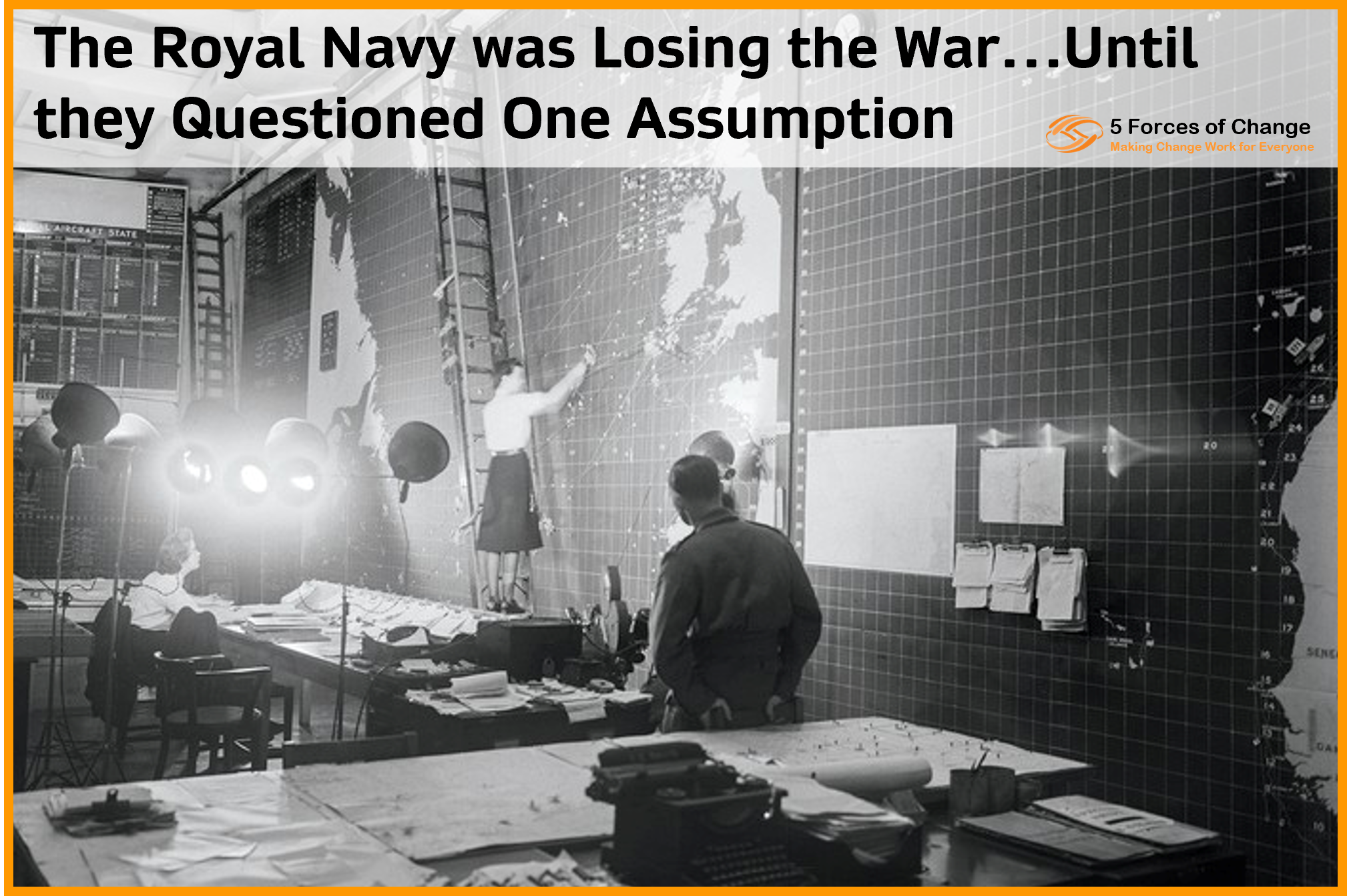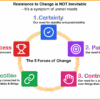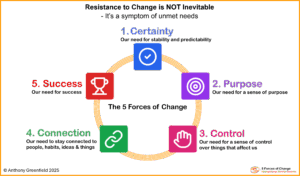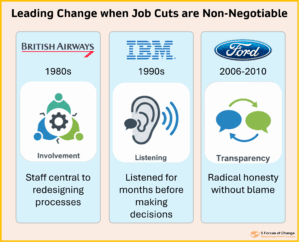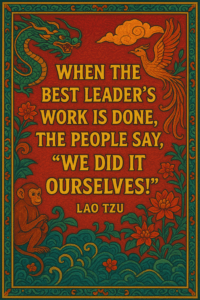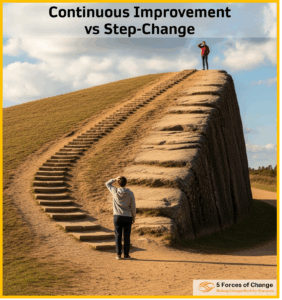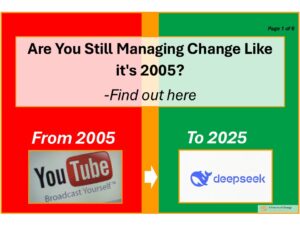You’ve seen it happen. A talented leadership team identifies a problem, implements a solution, and six months later – the problem is back. Often worse than before. This isn’t a failure of execution. It’s a failure of learning. In early 1942, Britain faced this exact pattern – but the stakes were national survival. The Royal Navy Was Losing the War… Until They Questioned One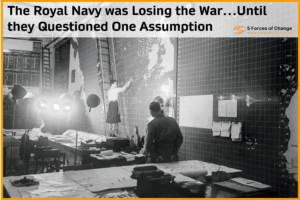 Assumption
Assumption
When Perfect Execution Isn’t Enough
German U-boats were sinking merchant ships faster than they could be replaced. Britain’s imports had plummeted from 68 million tons to just 26 million. The nation was on the verge of starvation.
The Royal Navy wasn’t sitting idle. They were executing their anti-submarine strategy perfectly: when convoys were attacked, escorts would aggressively pursue the U-boats, driving them away to protect the merchant ships.
The tactics were right. They had the best training. Everything was being done by the book.
And they were losing.
The Team That Changed Everything
Enter the Western Approaches Tactical Unit (WATU) – a small team led by Captain Gilbert Roberts and staffed primarily by young women from the Women’s Royal Naval Service. Their mission: figure out what was going wrong.
They didn’t have access to better ships or more resources. What they had was a willingness to question the fundamental assumptions everyone else took for granted.
Through intensive wargaming sessions, they made a startling discovery. Everyone assumed U-boats attacked from outside the convoy formation – it was the foundation of all defensive tactics. But when they simulated actual battles, the results didn’t match this assumption.
The truth: U-boats weren’t attacking from outside. They were positioning themselves directly in the convoy’s path, letting ships pass overhead, then surfacing to attack from behind – from inside the defensive perimeter.
The Assumption That Nearly Cost the War
The prevailing belief: “When attacked, we must aggressively chase U-boats away to protect the convoy.”
It made perfect intuitive sense. It’s what any warrior would do – pursue the enemy, drive them off, show strength.
But the WATU team asked a different question: “What if chasing them is exactly what they expect? What if our aggressive pursuit is leaving the convoy vulnerable?”
This was double-loop learning in action – not asking “how do we chase them better?” but “should we be chasing them at all?”
The Solution That Felt Wrong
The answer they developed was called “Raspberry,” and it violated every instinct:
When a ship was torpedoed, instead of racing ahead to hunt the U-boat, escorts would fall back behind the convoy and form a tight defensive line. They would wait.
The U-boat commander, thinking the danger had passed, would surface to reposition or recharge batteries. And the escorts would be waiting.
It felt counterintuitive, passive, and like giving up the initiative.
It worked immediately.
By May 1943, U-boat losses had become unsustainable. They withdrew from the North Atlantic. The tide of the war had turned – not because of better technology or more ships, but because someone questioned an assumption.
The Pattern Hiding in Plain Sight
This is the trap most leaders fall into. We’re excellent at single-loop learning – detecting and correcting errors within our existing framework. The thermostat adjusts when it gets too hot, but never questions whether the temperature setting itself is right.
Double-loop learning goes deeper. It questions the underlying assumptions, goals, and mental models that guide our actions. It asks: “Are we solving the right problem?”
And here’s what systems thinking reveals: the Royal Navy wasn’t just making a tactical error. They were trapped in a reinforcing loop:
Aggressive pursuit → Convoy left vulnerable → More ships sunk → More aggressive pursuit
Their solution was feeding the problem. And they couldn’t see it because the mental model – “aggression equals protection” – was invisible to them.
The Five-Step Journey From Frustration to Transformation
Every breakthrough in double-loop learning follows the same pattern. I call it the full journey of double-loop learning:
- The frustrating pattern – The problem keeps happening despite your best efforts
- The hidden assumption – The unexamined belief that’s driving your actions
- The double-loop question – The courage to challenge that core belief
- The counterintuitive solution – A change that feels risky or wrong
- Why it works – You’ve addressed root causes, not just symptoms
Let’s see how this played out in the Royal Navy case:
Pattern: Convoy losses accelerating despite better tactics Assumption: “Chase U-boats away to protect convoys” Question: “What if chasing makes us more vulnerable?” Solution: Fall back and wait – the Raspberry tactic Why it worked: Addressed where U-boats actually were, not where we assumed they were
This Pattern Is Everywhere
Once you see this pattern, you see it everywhere in organisational life.
The software development team spent weeks creating detailed project proposals with precise timelines. Every proposal proved wildly inaccurate. The single-loop response? “Get better at estimating.”
The double-loop question: “Why do we assume clients need detailed proposals when they’re always wrong? What if the entire handoff to a separate sales team is the problem?”
They made developers responsible for client acquisition and replaced detailed proposals with honest sprint-range estimates. It felt risky – “sales teams sell, developers develop” was deeply embedded. But eliminating the broken handoff and embracing transparency worked far better than increasingly detailed fiction.
The community hospital tracked performance metrics religiously, but staff felt powerless to improve outcomes. The single-loop response? “Better compliance, more training.”
The double-loop question: “What if ‘follow the process’ prevents people from actually improving anything?”
They shifted from compliance-based metrics to giving employees authority to interpret results and influence change. Empowerment beat standardisation.
The Reflexive Loop: How Beliefs Filter Reality
Here’s the uncomfortable truth the Royal Navy example reveals: your mental models don’t just drive your decisions – they filter what you see in the first place.
If you believe “aggression protects,” you’ll see every attack as proof you need more aggression. You won’t notice that your aggression is leaving gaps in your defence.
If you believe “presence equals productivity,” you’ll notice every empty desk and miss every innovative idea generated during a walk.
If you believe “more control improves performance,” you’ll see every mistake as proof that people need closer supervision.
This is the reflexive loop, and it’s why intelligent, well-intentioned leaders persistently make the same mistakes. Your beliefs determine what data you select from reality, which reinforces your beliefs, which determines what you see next time.
The Royal Navy could have kept improving their pursuit tactics forever. They were already very good at it. But being excellent at the wrong thing is still wrong.
Breaking this cycle requires deliberately stepping back and asking: “What am I not seeing because of how I’m looking?”
Making This Practical: Three Moves for Monday Morning
- Map your reinforcing loops
The next time you face a recurring problem, draw the causal connections like I did with the convoy example. Does your solution appear anywhere in the loop that’s creating the problem? If yes, you’re treating symptoms, not causes.
Ask yourself: “Could our response be feeding the pattern we’re trying to break?”
- Dig beneath the event
Use the iceberg model: What’s the event? What’s the pattern over time? What structures enable that pattern? What beliefs drive those structures?
The Royal Navy moved from the event (ships sunk) to the pattern (accelerating losses) to the structure (pursuit tactics leaving gaps) to the belief (aggression equals protection). The transformation happened at the belief level.
- Climb down your ladder of inference
When you have a strong conviction about what needs to happen, trace it backwards. What conclusion led to this belief? Which assumptions led to that conclusion? What meaning did you assign to the data? Which data did you select – and what did you ignore?
The Royal Navy assumed U-boats attacked from outside because that’s what surface raiders had always done. They selected data that confirmed this (some attacks from the perimeter) and ignored data that didn’t (the timing and location patterns that suggested internal positioning).
Often, you’ll find your certainty rests on surprisingly shaky ground.
The Discomfort Is the Point
Double-loop learning isn’t comfortable. The Raspberry tactic felt wrong to experienced naval commanders. Letting developers handle sales felt wrong. Giving up control felt wrong.
That discomfort – the feeling that you’re doing something incorrect – is often the signal that you’re finally addressing the root cause instead of just treating symptoms.
It requires questioning your own expertise, challenging assumptions that have served you well, and accepting that your mental models might be part of the problem.
But here’s what the Royal Navy example shows us: in complex, rapidly changing environments, the ability to question your fundamental assumptions isn’t just nice to have – it’s the only sustainable competitive advantage.
Your competitors can copy your strategy, your processes, even your culture. They can’t copy your capacity to fundamentally rethink what game you’re playing.
The Royal Navy’s enemies had better submarines, better torpedoes, better positioning. But once the British questioned their assumptions, none of that mattered. The mental model shift was more powerful than any technological advantage.
The Question Every Leader Should Be Asking
The Royal Navy was executing perfectly. They were disciplined, brave, skilled, and committed. They were also wrong about something fundamental.
How do you know you’re not in the same position right now?
The hardest questions aren’t about execution. They’re about examining the beliefs we’ve stopped noticing. The assumptions that seem so obvious we don’t even recognise them as assumptions anymore.
One keeps you competitive today. The other prepares you for a future that doesn’t look like the past.
Which mental models is your organisation not questioning? What pattern keeps repeating despite your best efforts to fix it? What assumption, if wrong, would explain everything?
These are the questions that separate single-loop optimisation from double-loop transformation.
The Royal Navy faced starvation and defeat. You probably face lower stakes. But the principle is the same: sometimes the most important thing you can do is stop doing what you’re doing – no matter how well you’re doing it – and ask if you’re solving the right problem.
The Royal Navy Was Losing the War… Until They Questioned One Assumption. At ‘The 5 Forces of Change’ we challenge people’s assumption about organisational change.

